The Big Five Crime Comics Series: Sin City, Criminal, Scalped, 100 Bullets, and Stray Bullets
When talking crime comics, you have to talk Sin City, Criminal, 100 Bullets, Scalped, and Stray Bullets
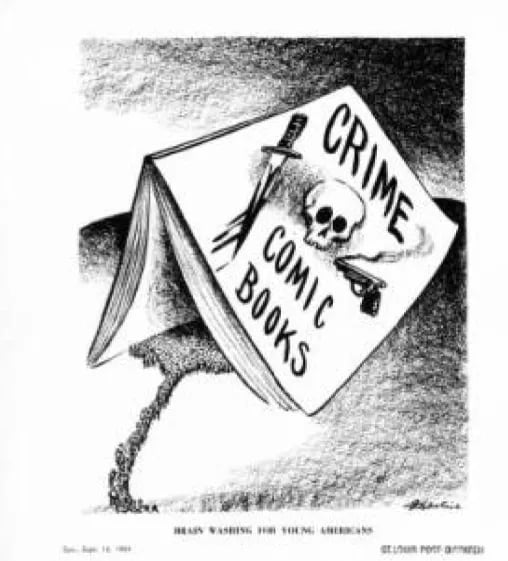
Let’s start creating a foundation for this project. If we’re going to be talking about crime comics, we have to mention the big dogs. Long running U.S. crime comic series that were popular, and well received when they were published, and are still considered great comics and remain popular to this day. To the extent there is a crime comics canon, at least in the sense of those crime comics titles that a lot of people know about, these are a part of it. If you ask most people what the best crime comics are and/or what their favorite crime comics are, there’s a good chance many of them will choose one of these: Sin City by Frank Miller, Criminal by Ed Brubaker & Sean Phillips, Scalped by Jason Aaron & R. M. Guéra, 100 Bullets by Brian Azzarello & Eduardo Risso, Stray Bullets by David Lapham.
As we’ll discuss in upcoming posts, these aren’t the only crime comics series, the nature of crime comics series in the US also seems to have changed, there are lots of crime comics series from other parts of the world, and these aren’t even the longest running crime comics series (that distinction belongs to a manga). So we’ll start here with these well known titles, then branch out to other parts of the world, then look at how things seem to have changed.
This will be a longer post because there’s a lot to cover. Future posts won’t likely be this long. Each of these five titles have been written about a lot so this post will not be a full review of those titles (and Criminal will soon get a lot more ink when the Prime series comes out). Just an overview and some quick thoughts. Within the past 18 months or so, I’ve re-read Stray Bullets, Criminal, and 100 Bullets and I haven’t yet done a re-read of Sin City and Scalped. I’m not ruling out a deep dive on these titles later on.
First is Frank Miller’s Sin City (Dark Horse), which first started being published in 1991. It’s a series of story arcs (called “yarns”) featuring a large cast of characters in a fictional city. Sin City was adapted to film by Robert Rodriguez in 2005. The individual yarns are: The Hard Goodbye, A Dame to Kill For, The Big Fat Kill, That Yellow Bastard, Family Values, Booze, Broads, & Bullets, and Hell and Back. Sin City has been collected in different ways, is still in print, and is readily available in print or digitally.
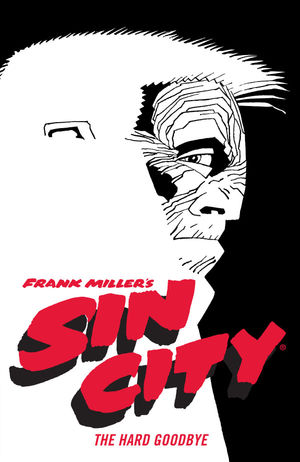
There’s a couple of ways you can see Frank Miller’s influence on crime comics. The first is using illustrated sound effect words to convey action and sometimes express the exaggerated pulpy violence of a scene. For example Frank Miller loved the expressiveness of “BLAM”.
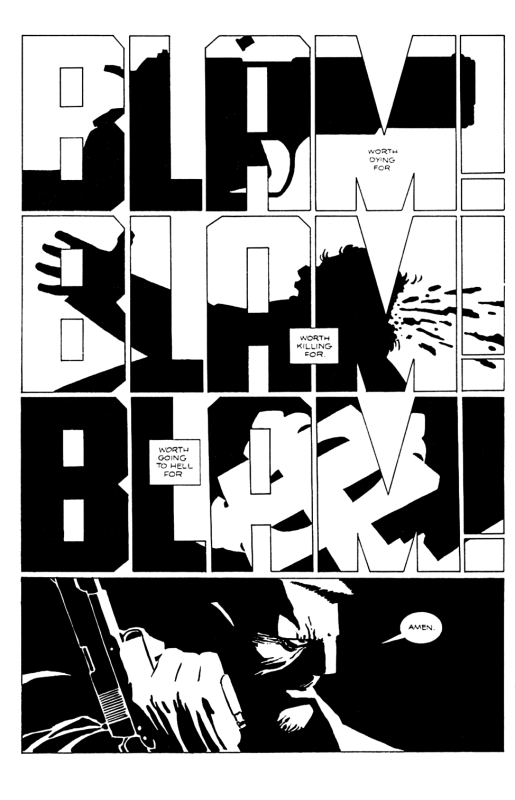
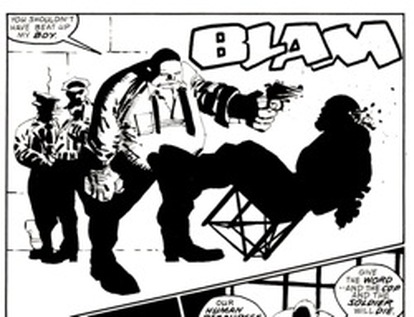
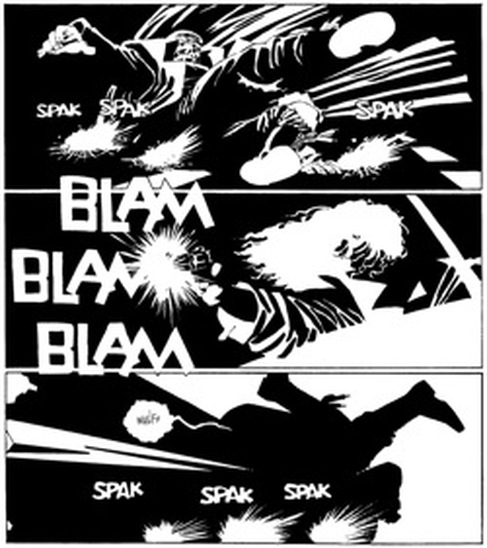
The second is Frank Miller pulling his influences from crime films. I do think that crime flicks lend themselves as a greater influence on crime comics than crime fiction novels. Which makes sense given the visual nature of both mediums and ease of availability.
“I've been a fanatic for a long time for old crime movies and old crime novels. But it started with the movies. And the old Cagney movies. Bogart and all that.”
One other facet of Frank Miller’s and Sin City’s influence is his usage of black and white coloring in a stylized way. In classic film noir, there is often a heavy emphasis placed on dark shadows. I think Miller chose to emulate this with heavy black colors and negative space. This reliance on heavy black usage would show up in other crime comics also and it would take awhile for more elegant, mid-century modern, finely detailed art styles to emerge that were more closely grounded in reality and pulled away from heavy stylization.
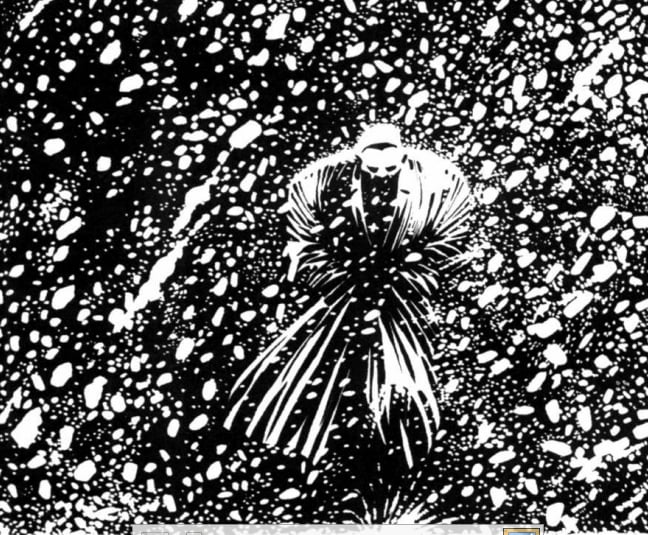
Finally, Sin City’s “sand box” or shared world approach will be taken up by others too. The idea of creating a fictionalized setting (or a fictionalized version of a real place) in which to let loose a cast of characters in a variety of stories.
There’s a great Umberto Eco quote that gets to the heart of some of Sin City’s charm.
"Two cliches make us laugh. A hundred cliches move us. For we sense dimly that the cliches are talking among themselves, and celebrating a reunion." -- Umberto Eco
Crime fiction can be a trope heavy genre, and the same is true for crime comics. But that’s also part of the fun. Gather the tropes together, love them with an open heart, then shoot at their feet and make them dance.
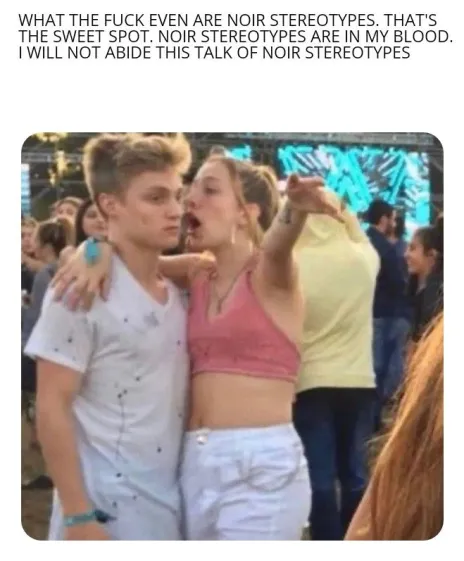
Which leads us to Ed Brubaker’s & Sean Phillips’ Criminal. Criminal first came out in 2006 from Image and the series continues to the present, with a new volume coming later in 2025. It remains in print and is easily and readily available.
Criminal is an extended exercise in crime film tropes played out in interconnected stories and characters whose histories and stories are also connected. The characters are recognizable crime fiction types, brought to life with great writing and brilliant art. Unlike Frank Miller’s Sin City, which eschews realism for a very stylized black and white style, Criminal’s style is much closer to realism.
“What Ed Brubaker and Sean Phillips have created in this series of books is a world that feels like a 40's/50's film noir or gangster movie, but populated by the children of the 70's blaxploitation and grind- house pictures. But to their credit they've done much more than create a series influenced by other mediums. Brubaker and Phillips have made this seedy atmosphere... personal.” — John Singleton
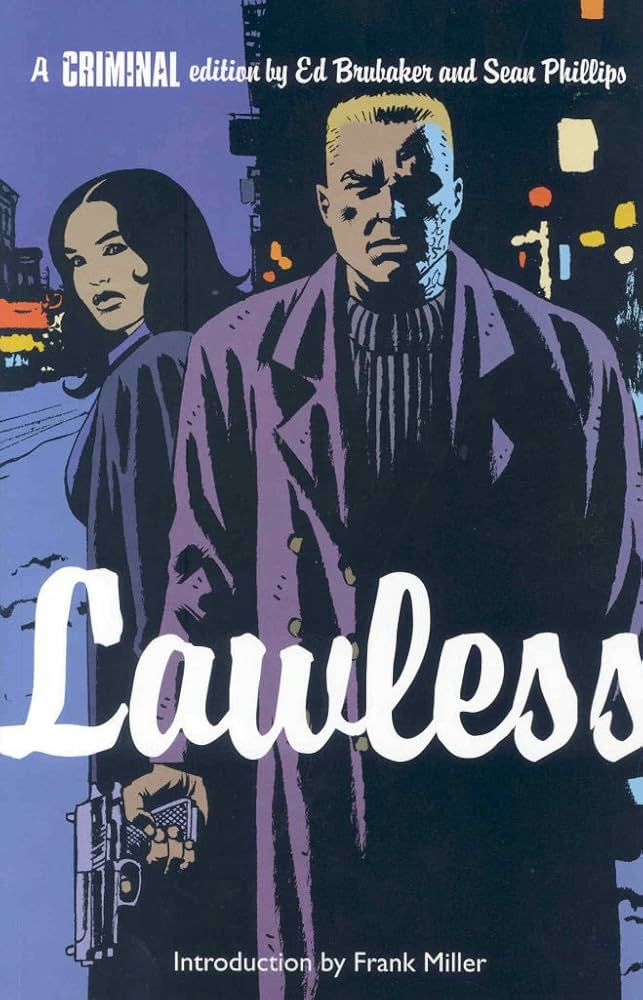
This works really well with the tropey/archetypal nature of the characters because the art style helps add more depth and dimension. Sin City’s characters feel extreme and monstrous at times and Criminal’s characters could be your sketchy uncle at holiday dinners who used to make a living by driving cars into Baltimore’s Inner Harbor to facilitate false insurance claims and always seemed to know a guy.
“One of my intentions with this series was to create a book that could handle any and every story I wanted to tell. The cast of the book is a loose-knit gang of crooks - a pickpocket, a hit-man, and a crooked cop, for starters - who each take center stage at different times. This way I can do a heist story, follow that with a revenge drama, and then a prison breakout, all while using the same characters. And as each story unfolds, the mysterious past that connects these characters is revealed, so readers can watch the puzzle of their twisted history being put together.” — Ed Brubaker
Look, Criminal is a Great comic book period full stop. Which also makes it one of the Great crime comics period full stop. Brubaker is a wonderful writer and his crime comics bonifides are rock solid. If his name is on it it’s probably worth checking out and I would expect to see his work come up again in future posts here (in fact, I’m reading Kill or Be Killed at the time I’m writing this). This is really great crime fiction and Brubaker knows his stuff and is clearly a fan of the genre.
It’s also worth mentioning that it’s worth grabbing individual issues if you see them. They are filled with back matter essays about the crime genre. These essays have never been collected in any other format and are great reads in their own right.
The question for reading Criminal boils down to, do you like crime fiction? Yes of course, then read Criminal.
Scalped was first published by Vertigo in January 2007 and the story is complete at 60 issues. It has remained in print in various formats. There are 10 trade paperbacks, 5 deluxe editions, and two omnibus editions that each collect the entire series.
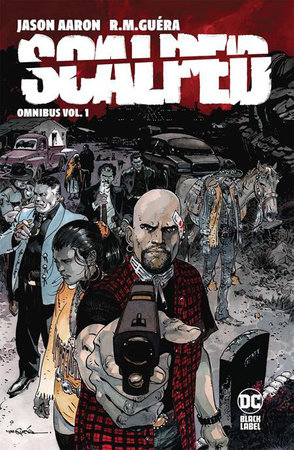
Scalped is a crime series that combines elements of action and crime stories bundled up neatly together with strong noirboiled elements.
The action is unmistakable from the opening bar fight, where we first meet Bad Horse, when, right before the action starts, he proclaims “Whicha you motherfuckers is gonna be the first to cry to Jesus.” From that point on fights will be started, weapons will be pulled, buns will blaze and the action will be relentless. The crime elements will feel familiar to some but only at the most superficial levels as it will only take a light scratch to reveal the depths of these characters that are anything but simple clichés. From the simple synopsis of the story these two elements can be surmised but the pervasive noir story was a pleasant surprise.
Bad Horse may be a tough guy but we quickly understand that he is an every-man that we can relate to in a lot of ways. He finds himself compelled, by forces largely beyond his control, to enter into a situation where he becomes little more than a pawn. With all these outside forces working against him the urge for his individuality to assert itself becomes stronger and stronger; but as these forces become practically insurmountable this simple task becomes harder and harder. Before long a complex mousetrap has been set for Bad Horse. At the end of the first issue there is a major revelation about one of the characters that changes the face of the entire story. Just about every issue ends in a great cliffhanger moment that compels you to read further and the art accompanying these tense moments becomes fraught with peril and potential destruction.
Through all of these characters, and this story, a lot of tough questions about America, race, class, vice, identity, history, cultural identity, loyalty, youthful ideals and their potential corruption will be asked. Some answers will be given but none of the questions and their potential answers are easy or neat and pretty.
Scalped is a book that both entertains and makes you think.
I wrote many of those above words in my original review of the first trade paperback many years ago. The world has changed a lot since then.
The biggest change is that the show Reservation Dogs aired for three seasons. A Native show, written by Native creatives, featuring a mostly Native cast. It’s basically a who’s who of Native actors and actresses across multiple generations. In my opinion it became a top tier show. It doesn’t shy away from dark themes but offers a more balanced view of “life on The Rez” including the daily humor of these characters. So what does Scalped read like in a post Reservation Dogs world? Great question that I’ve thought about but haven’t really settled on an answer yet. Scalped is a bleak, depressing, downer tale that avoids much of the humor in Reservation Dogs.
How do you tell a full dark, tragic, noir story about marginalized groups and their communities while avoiding the traps and pitfalls that already exist around those groups in fiction and in life while avoiding the blind spots that a creator not from that community may have. Because all the research in the world isn’t the same as lived experience. The response to the movie Queen & Slim gets at part of this conversation. Or at least illustrates some of the difficulties. As a piece of crime fiction with a tragic ending, it’s a pretty good movie. But dig a little deeper and its politics and message is messy. Scalped is a good piece of crime fiction but I’d like to know more about what’s underneath.
I’m not making a value judgement about Scalped and it’s themes and characters. I don’t have the lived experiences to do so. All I’m saying is that I would love to read a critical analysis of Scalped from a Native perspective.
100 Bullets is published by Vertigo. It’s written by Brian Azzarello and illustrated by Eduardo Risso. It started in 1999 and ran for a decade with a complete story at 100 issues. Similar to Scalped, it’s collected in trade, deluxe, and omnibus editions.
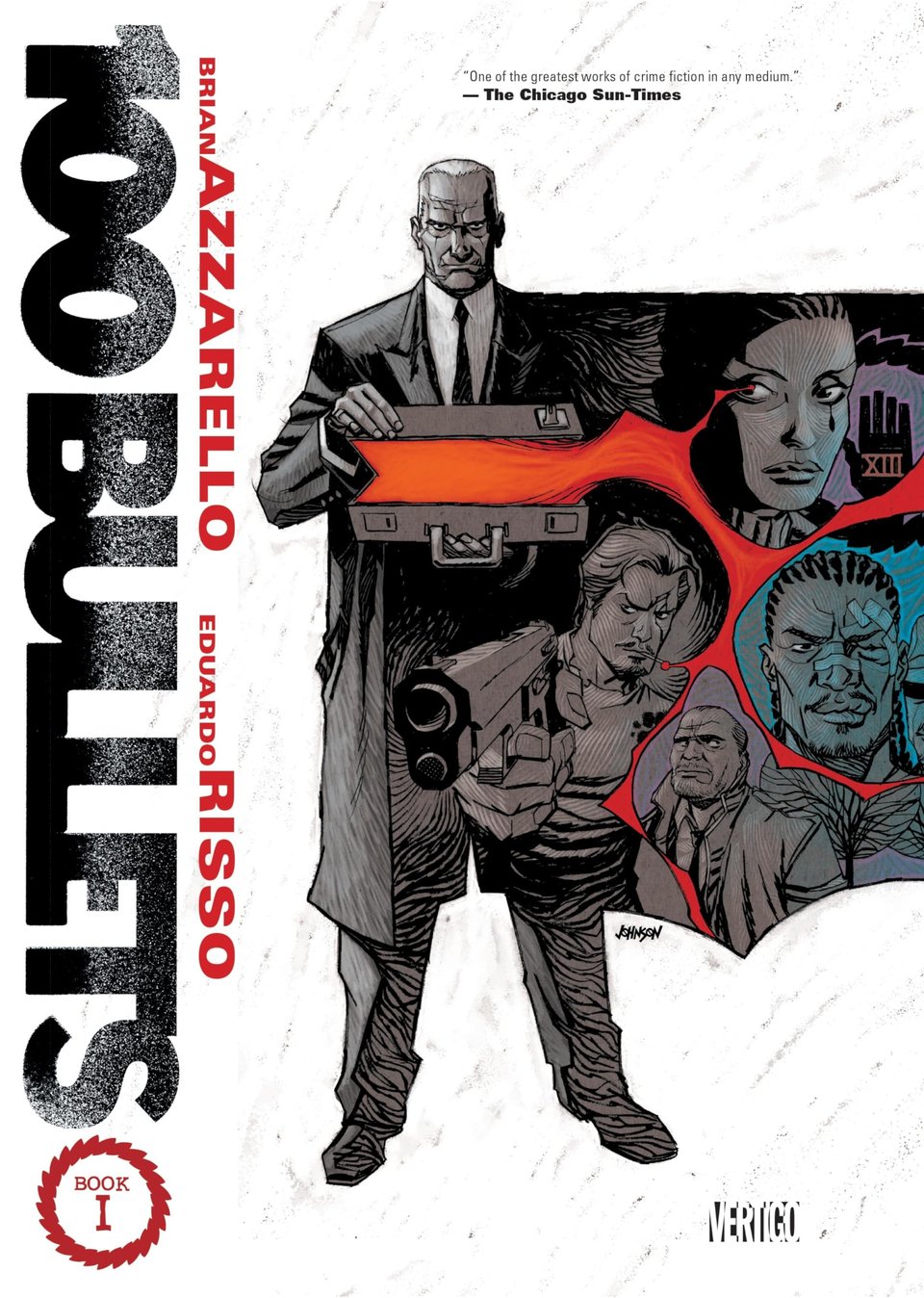
100 Bullets has a rock solid starting premise. A mysterious man shows up and hands you a briefcase with a gun and one hundred bullets. In the briefcase is a dossier on the person who is most responsible for your lot in life. The gun and bullets are untraceable and you won’t face any legal consequences. What you do with this information is up to you.
It is perhaps notable that 100 Bullets and the prestige TV era start at the same time. Those initial story arcs are fairly self-contained morality tales about those decisions; however, those briefcase recipients soon find themselves as players in a much larger story that spans the globe, history, and the secret levers of power. The ways that this story grows and expands is kind of insane. There had been talk of an adaptation of 100 Bullets and it would have to have been a major, multi-season commitment to even have a chance of being successful. However, that project never got off the ground.
I will say this. I recently re-read 100 Bullets and I think the story gets a little too sprawling at times. Its scope and scale and cast are so expansive that it’s a little unwieldy in places. I also think some of the characters border on racial caricature and that was a little jarring. With those notes in mind, I do think 100 Bullets is worth tackling at some point if you have never read it and worth revisiting if you have. If nothing else, it’s certainly a wild ride and you can’t deny its place as one of the major crime comics series.
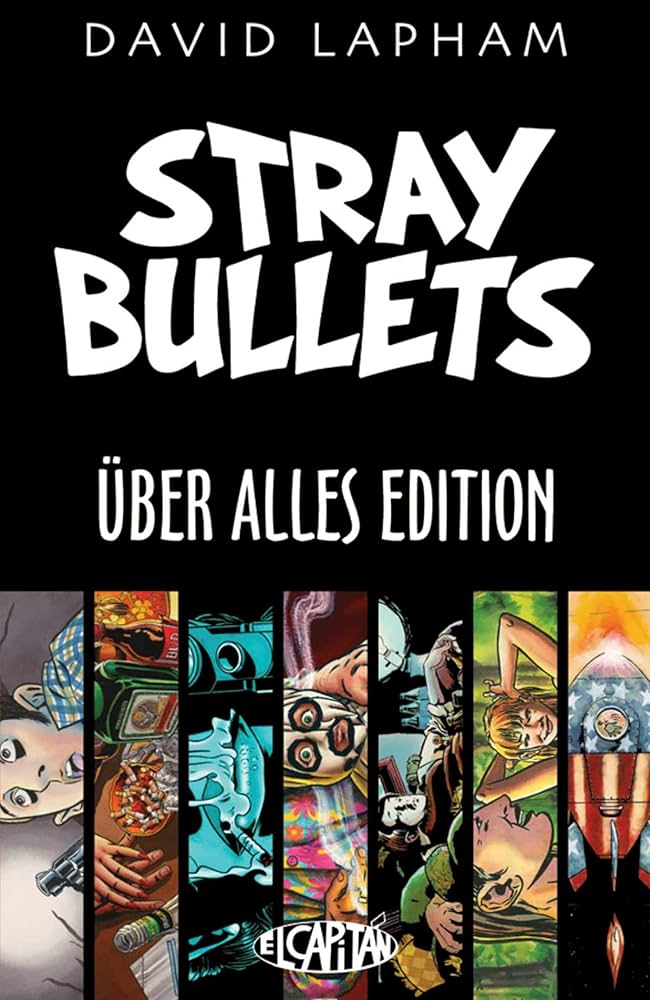
Stray Bullets is written and illustrated by Davis Lapham. The first issue came out in 1995. There are presently 91 issues over three arcs (Stray Bullets 41 issues, Killers 8 issues, Sunshine & Roses 42 issues). Each arc tells a complete story with each complimenting the already existing world. There is still more story to tell with these characters and hopefully we will be blessed with more. They are mostly collected and relatively easy to find digitally and in print form.
If you ask people what the greatest crime comic of all time is you will find that a consensus has basically been reached, Ed Brubaker’s Criminal. And it is a great piece of crime fiction period full stop.
However.
There is a vocal minority that will tell you with their whole chest that David Lapham’s Stray Bullets is the greatest comic of all time. Here, I confess that I am one of them. Generally speaking, I do find the G.O.A.T question silly though because it implies a singular great rather than multiple greats, eschews a more pluralistic philosophy of art, and can ignore influences and art that came before. But that’s probably a topic for another day 😉. Criminal heads I stand with you in my enjoyment and praise of Criminal. But Stray Bullets is my favorite crime comic though. I want to stop this paragraph here because I don’t want to imply that there is a need or desire to compare these two titles or reduce the conversation to a binary. The more great crime comics there are, the better for everyone. I want to live in a world where there are many great crime comics series like Criminal, Stray Bullets, Blacksad, Banana Fish, and many others. Just as Sin City and Criminal are in conversation with each other, Criminal and Stray Bullets are also having a conversation. And that’s a good thing.
"I always called Stray Bullets a domestic noir, meaning that it's a domestic drama using all the heightened elements of a noir story, but in the end, it doesn't matter if the characters are actual criminals and cops, or whatnot." - David Lapham
Stray Bullets utilizes a mosaic approach across a wide canvas to piece together a large cast of characters and a sprawling epic story. Early issues have a loose feel as each one starts with a different scenario and new characters. It’s only over some time that the connections between these issues start to make themselves known and things start to coalesce. This isn’t a story about crime bosses and their criminal empires, though one like this does play out in the background. This is a story about the people in the lower strata of that realm. As a larger more traditional crime story plays out in the background, these characters are just trying to survive and scratch out an existence. Harry, the crime boss in question, remains unseen to this day, though his presence and influence is felt by everyone of these characters.
“Stray Bullets is a series of interconnected short stories dealing with mostly innocent people whose lives are affected by violent events. Many times emotional, psychological, but also physical. And how that sort of warps them. And how they lead, basically, dysfunctional lives. It’s a crime drama series heavy on the drama.” – David Lapham
While the focus is always on the small scale interactions and relationships the scope will be grander in scale. So characters you meet in earlier issues will grow and change later on. If you meet a character later in the series who is a bad dude with a scary reputation, you will have seen him do some bad shit earlier in the series, so the rep is well earned and not just narrative shorthand for the reader. Instead of a collection of story arcs that come together to form a larger story, Stray Bullets is a collection of character arcs that come together to form a larger story. It’s a subtle distinction but an important one and one that sets the series apart. This is an intricate, carefully considered, ground level story. Stray Bullets is both sprawling and intimate.
Stray Bullets is a cult classic crime comic. It deserves as much recognition as the other titles talked about in this post and has earned its place in the big five. Give it a shot.
Also, Happy 30th Anniversary to Stray Bullets.
So how about it, have you read any of the Big 5 titles? What’s your history with them? Do you have a favorite? Are you looking forward to the upcoming Prime show?
You just read issue #3 of Bad Karma, Loose Ends & Stray Bullets: Exploring the World of Crime Comics. You can also browse the full archives of this newsletter.